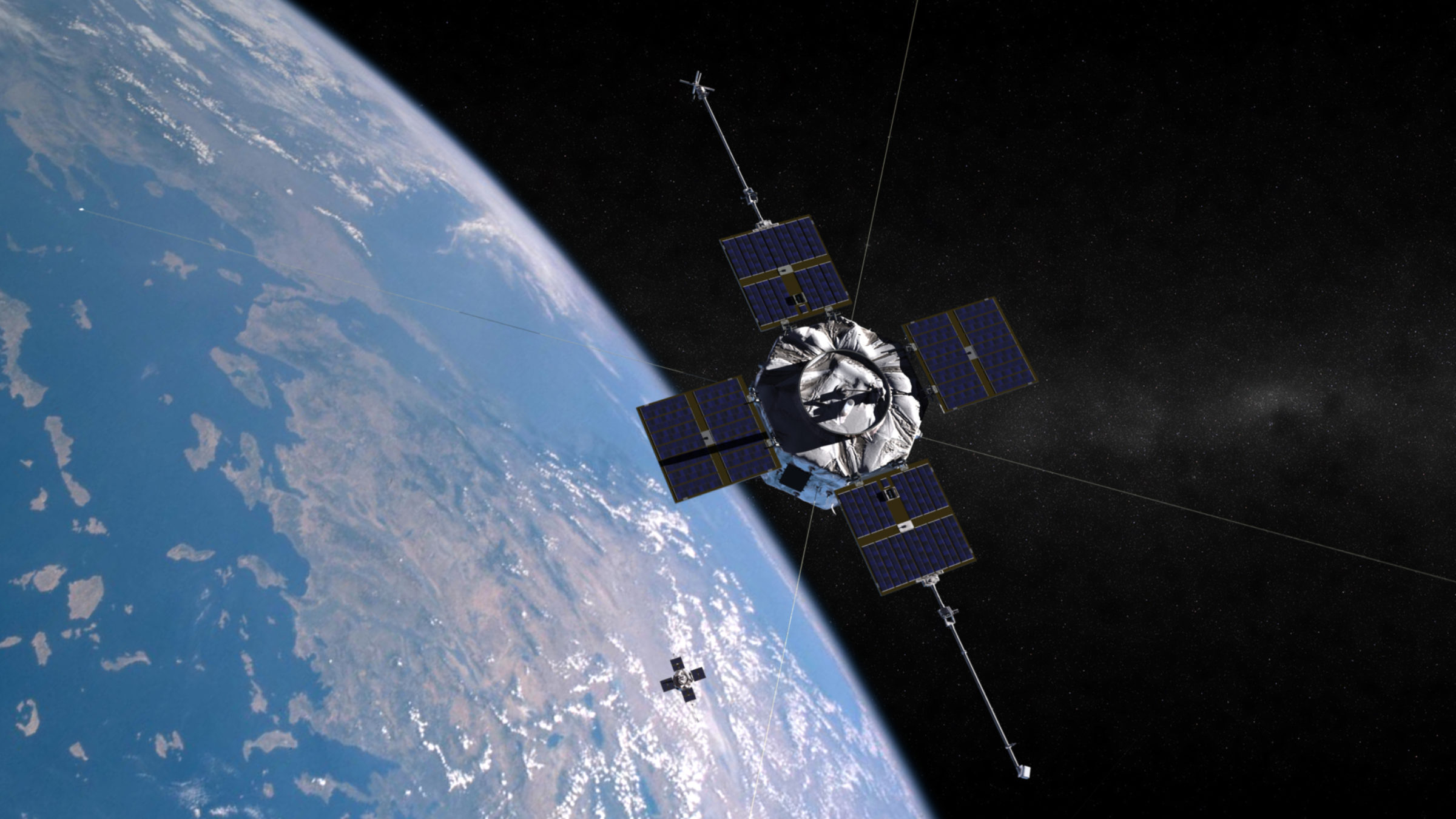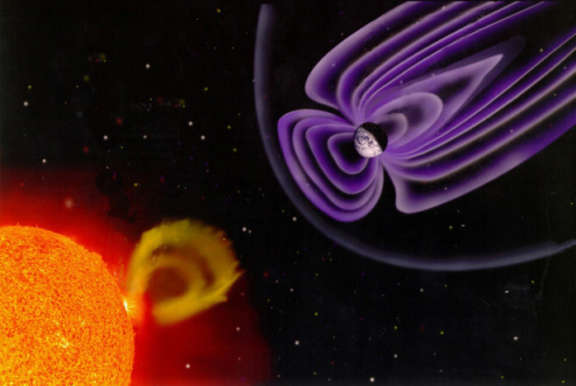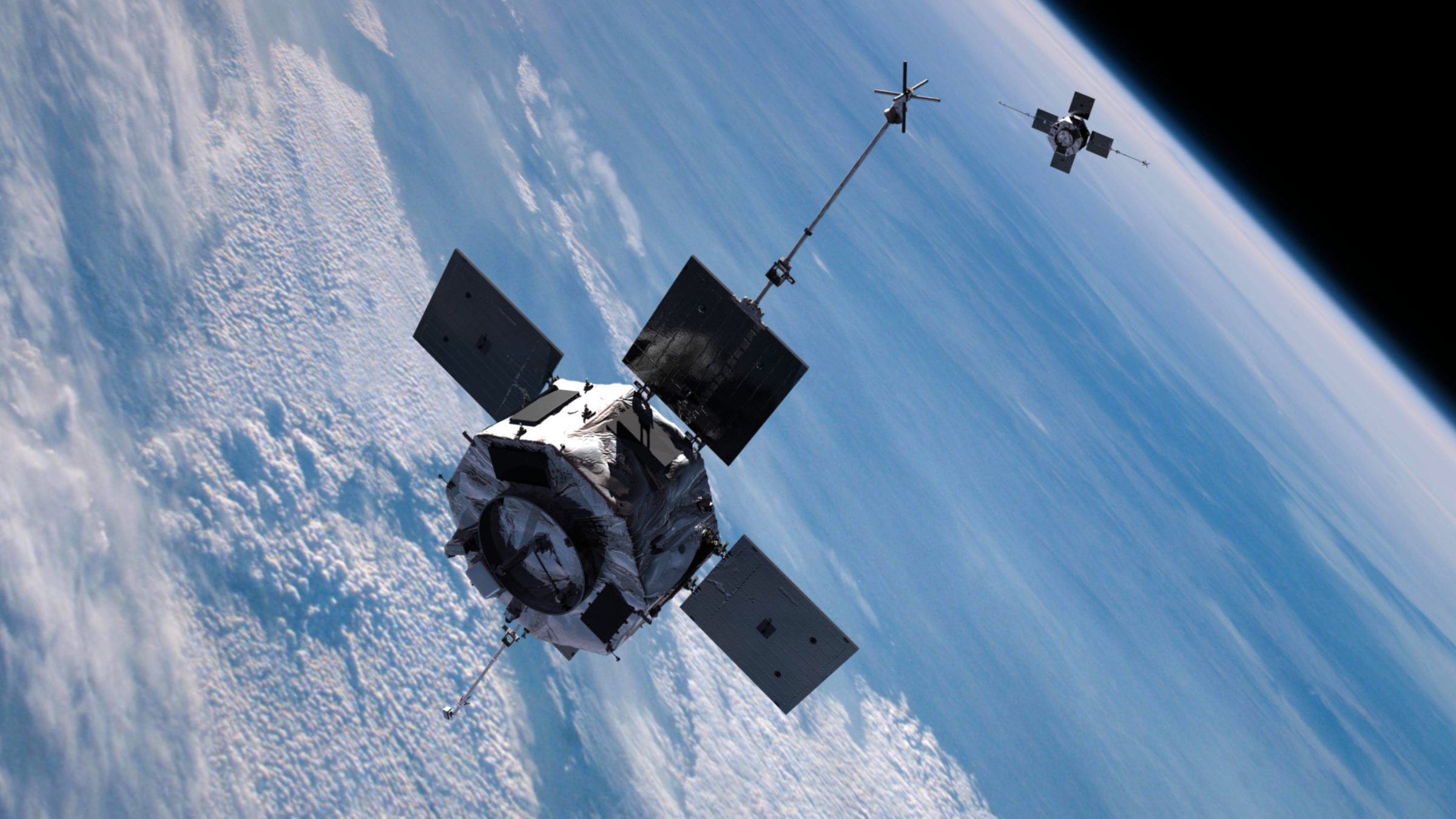Geoffrey Reeves • Jun 05, 2018
Big news from the magnetosphere
It’s an exciting time for space weather research. NASA’s twin Van Allen Probes have recently completed their third circuit of Earth measuring the radiation and charged particles that stir up space weather. Data from the mission has upended our understanding of the Van Allen Radiation Belts and the particles zipping around in them. Those things matter to astronauts, satellite operators, and even electric utilities on Earth. Information from the third circuit, which is an unexpected bonus round, will help us even further refine these new models of the belts.
So far, the big news has been that the Van Allen belts are not always, as scientists once thought, two concentric, well-formed donuts wrapping around Earth. Since the 1960s, scientists have believed that only the outer belt interacted with solar storms and coronal mass ejections, and only the worst of those. Now we know that, under the constant bombardment of solar particles, the belts can dramatically change shape.

What are the Van Allen belts?
It’s common to think of space as an empty void, a vast emptiness filled with nothing but starlight and the hum of 13-billion-year-old background radiation left over from the Big Bang. Not true! Human eyes can't see it, but the space inside the solar system is full of magnetic fields and tiny particles.
Solar flares, which are intense bursts of radiation from sunspots, and coronal mass ejections, which are bursts of gas and magnetic fields, erupt from the surface of the Sun. During these solar storms, a constantly changing stream of mostly electrons, protons and some heavier ions erupt from the Sun and streak across space at millions of kilometers per hour, often straight at Earth. This solar wind pummels our magnetosphere in geomagnetic storms.

The magnetosphere is the magnetic-field region around Earth. If you think of the lines of force that you can see when you sprinkle iron filings on a paper over a magnet, you get the idea. The magnetosphere changes all the time under the Sun’s influence. For example, the Sun squishes the sunward side of the magnetosphere at local noon, while the night side stretches out in a long, dynamic “magnetotail.” As particles come in from the magnetotail, some are deflected toward dawn and some toward dusk (right and left around the Earth), depending on their charge and energy. Charged particles can move easily along a magnetic field but can’t move easily across the field or from regions of weak fields into regions of strong fields. As a result, energetic charged particles get “trapped” in the Earth’s magnetic bubble to form the radiation belts.
The Van Allen Belts are a region of charged particles held in place by the magnetosphere. Named for their discoverer, James Van Allen, the belts swell and shrink over time. The belts swell when already energetic electrons and protons are pumped up to relativistic energies during geomagnetic storms. They can shrink if electrons manage to escape from radiation belts – either along the field down into the Earth’s atmosphere or back out into interplanetary space.

Since the 1960s, space scientists have long described the shape of the belts as two distinct, concentric donuts formed around the lines of force in the magnetosphere. We thought of the inner belt as small and quiet, wrapping the Earth about 600 to 10,000 kilometers above the surface. The second, larger belt was believed to stretch from about 12,000 to 58,000 kilometers above the surface.
It turns out that description isn’t entirely right. Recent research has found that the belts change in shape under the influence of solar storms, and the belts look different depending on the energy levels of the particles being studied.
The Van Allen Probes
On August 30, 2012, NASA launched the two Van Allen Probes spacecraft into a highly eccentric orbit that covers the entire belt region and exposes them to its constantly changing densities and varying intensities of electrons, protons, and other ions. With just one probe, scientists would be unable to tell at any given moment whether its observations were measuring transient disturbances to the whole system or the specific, static local conditions of its immediate surroundings. By taking simultaneous two-point measurements, however, a pair of spacecraft with identical instruments can distinguish between these possibilities, capturing the big picture.
The probes follow a highly elliptical path tilted 10 degrees from Earth’s equator, ranging from 600 kilometers to an apogee of 30,000 kilometers, almost the height of geosynchronous orbit where most of our satellites operate. They go from the closest point, perigee, to the furthest point, apogee, and back again in 9 hours. The local time where apogee happens slowly drifts, sweeping through 360 degrees over a period of about a year and a half. Each of these year-and-a-half periods is called a "circuit." The Van Allen Probes are now in their fourth circuit.
Unlike many spacecraft, the spin axis of each probe always points toward Sun, an orientation that requires fuel to maintain. Fuel will probably run out in mid-2019, ending the mission. Mission planners had designed the probes to operate for two years in the harsh radiation of the Van Allen Belts, but the spacecraft are still working after nearly six years and counting as of May 2018—thanks to good design by Johns Hopkins Applied Physics Laboratory and a more benign space environment than expected.

Bending the belts
Scientists used to think that the inner belt maintains a steady position above Earth’s surface. The new results, however, show that’s not always true. For example, during a very strong geomagnetic storm in June 2015, relativistic electrons at nearly the speed of light pushed deep into the inner belt. Another storm in 2012 actually split the outer belt increasing the number of belts from two to three.
Geomagnetic storms distort the belts’ structure. These storms can increase or decrease the number of energetic electrons in the radiation belts sometimes for months before the belts return to their normal configuration. During intense geomagnetic storms, when charged particles from the Sun hurtle across the solar system, the outer radiation belt pulsates dramatically, growing and shrinking. Often, the outer electron belt expands inward toward the inner belt during geomagnetic storms, completely filling in the slot region that usually lies between the two belts with lower-energy electrons, forming one huge radiation belt.
Electron vision
Past space missions could not distinguish electrons from high-energy protons in the inner radiation belt. These protons shoot through particle detectors, creating a noisy background from which the true electron measurements needed to be picked out.
But by using three new instruments, which make up the Energetic-particle, Composition, and Thermal-plasma (ECT) suite, the Van Allen Probes expand the range of energetic electron data we can capture. Despite the proton noise, the Van Allen Probes can unambiguously identify the energies of the electrons they’re measuring. In addition to studying the extremely high-energy electrons—carrying millions of electron volts—that had been studied before, the probes capture information on the full range of electrons from just a few to a few million electron volts. Additionally, the spacecraft measure radiation belt electrons at a greater number of distinct energies than was previously possible.
When we look across a broad range of energies with the ECT instruments, we start to see some consistencies in how these storms behave from one storm to the next. For example, we found that electrons fade from the slot regions quickly after a geomagnetic storm, but the location of the slot region depends on the energy of the electrons. At lower energies, the slot forms farther from Earth. The inner belt swells bigger than the outer belt. But when we look at higher energies, the slot forms closer to Earth, reversing the relative size of each belt. So, depending on what we focus on, the radiation belts show very different structures simultaneously.
Crucial protection
Precise observations from hundreds of energy levels, rather than just a few, will allow scientists to create a more precise and rigorous model of what, exactly, is going on in the radiation belts, both during geomagnetic storms and during periods of relative calm.
These findings have important implications for operating spacecraft, TV and weather satellites as well as national security ones. Understanding the shape and size of the belts, and how they shrink and swell in space weather, is crucial for protecting satellites and crewed spacecraft. Knowing exactly how much and what type of radiation is present in any given region of space will let enable scientists and engineers to design lighter and cheaper satellites tailored to withstand the specific radiation levels they’ll encounter.
The results will also help scientists better understand—and detect—effects from high-altitude nuclear explosions. Los Alamos National Laboratory has interest in the applications for space weather forecasting to protect satellites and also for monitoring the Nuclear Test Ban Treaty, which prohibits nuclear explosions in space. A high-altitude nuclear explosion creates an artificial radiation belt. We can learn about the physics of an explosion by looking at the hard-to-detect, natural, near-light-speed electrons in the Van Allen Belts. If an artificial radiation belt were ever detected, these new observations would help us understand it better.
Van Allen belts Learn about the Van Allen Belts and how new findings from NASA’s Van Allen Probes could impact how we protect technology in space.Video: Los Alamos National Lab
Support our core enterprises
Your support powers our mission to explore worlds, find life, and defend Earth. You make all the difference when you make a gift. Give today!
Donate

 Explore Worlds
Explore Worlds Find Life
Find Life Defend Earth
Defend Earth

